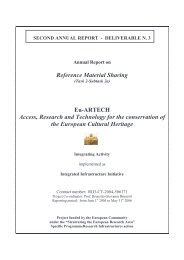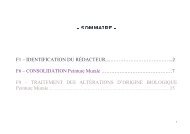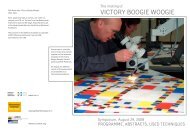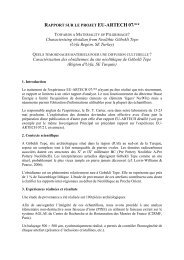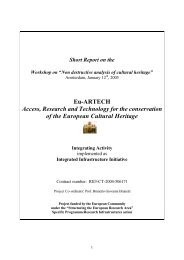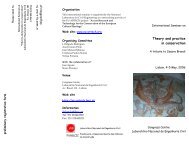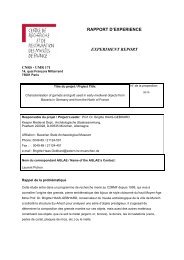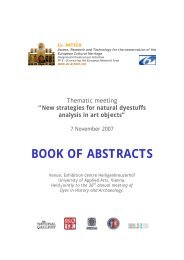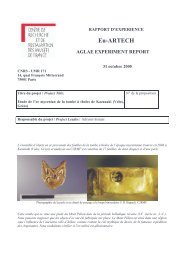Project: Study of the composition and structure of ... - Eu-ARTECH
Project: Study of the composition and structure of ... - Eu-ARTECH
Project: Study of the composition and structure of ... - Eu-ARTECH
Create successful ePaper yourself
Turn your PDF publications into a flip-book with our unique Google optimized e-Paper software.
Access, Research <strong>and</strong> Technology for <strong>the</strong><br />
Conservation <strong>of</strong> <strong>the</strong> <strong>Eu</strong>ropean Cultural Heritage<br />
Structuring <strong>the</strong> <strong>Eu</strong>ropean Research Area - Research Infra<strong>structure</strong>s<br />
MOLAB Access<br />
MOLAB User Report<br />
<strong>Project</strong>: <strong>Study</strong> <strong>of</strong> <strong>the</strong> <strong>composition</strong> <strong>and</strong> <strong>structure</strong> <strong>of</strong> lustre decorations on<br />
original Italian Reinassance lustreware<br />
User Group Leader: Lucia Burgio<br />
Location: Victoria <strong>and</strong> Albert Museum, London, United Kingdom<br />
The origin <strong>of</strong> <strong>the</strong> lustre decoration technique is one <strong>of</strong> <strong>the</strong> most complex issues in <strong>the</strong> history <strong>of</strong><br />
ceramics. Lustre preparation is described by Cipriano Piccolpasso in <strong>the</strong> second book <strong>of</strong> “Li tre<br />
libri dell'arte del vasaio”: a mixture <strong>of</strong> silver, copper <strong>and</strong> iron salts or oxides, toge<strong>the</strong>r with red<br />
ochre <strong>and</strong> vinegar, was applied onto <strong>the</strong> surface <strong>of</strong> <strong>the</strong> glaze, <strong>the</strong> kiln’s temperature was raised to<br />
approximately 600 o C, <strong>and</strong> smoking organic substances were added to create a reducing<br />
atmosphere in <strong>the</strong> kiln [1,2].<br />
Recent works demonstrated that lustre consists <strong>of</strong> a heterogeneous metal-glass composite film,<br />
some hundreds <strong>of</strong> nanometres thick, analogous to that present in <strong>the</strong> modern metal-glass<br />
nano<strong>structure</strong>d composites syn<strong>the</strong>sised for high technology applications [3]. In lustre, separate<br />
silver <strong>and</strong> copper nanoparticles appear dispersed within <strong>the</strong> outer layers <strong>of</strong> <strong>the</strong> glaze [4].<br />
However, an extended study on <strong>the</strong> original lustre wares executed by <strong>the</strong> ancient masters has not<br />
been attempted to date. This is <strong>the</strong> report on a fully non-destructive study carried out on eleven<br />
Italian Renaissance plates belonging to <strong>the</strong> V&A collections.<br />
Fig.1 The three Graces, a plate by Mastro Giorgio Andreoli<br />
at <strong>the</strong> V&A.
Three techniques were used: energy dispersive X-ray fluorescence (EDXRF), Raman spectroscopy<br />
<strong>and</strong> visible <strong>and</strong> near-infrared spectroscopy (Vis-NIR). The use <strong>of</strong> a portable EDXRF spectrometer<br />
allowed <strong>the</strong> detection <strong>of</strong> copper <strong>and</strong> silver, which can be related to <strong>the</strong> colour <strong>of</strong> <strong>the</strong> decoration.<br />
Portable fiber-optic Vis-NIR spectroscopy equipment allowed <strong>the</strong> quantification <strong>of</strong> colour <strong>and</strong>, at<br />
<strong>the</strong> same time, <strong>the</strong> qualitative detection <strong>of</strong> copper <strong>and</strong> silver nanoparticles. This identification can<br />
be carried out by way <strong>of</strong> <strong>the</strong> Surface Plasmon Resonances (SPR), typical <strong>of</strong> nanoparticles<br />
dispersed in a transparent medium [4-6]. Finally, <strong>the</strong> glassy network <strong>of</strong> <strong>the</strong> glaze was studied by<br />
portable micro-Raman spectroscopy. Raman spectra from many different areas <strong>of</strong> <strong>the</strong> lustre<br />
decoration were recorded, making it possible to compare spectra taken from different decorations<br />
<strong>of</strong> <strong>the</strong> same dish or analogous decorations in different dishes.<br />
The XRF results on <strong>the</strong> plate “The three Graces” by Mastro Giorgio Andreoli (see Fig. 1) are<br />
reported in Table 1.<br />
Table 1 – Cps (counts per second) values <strong>of</strong> <strong>the</strong> elements detected on <strong>the</strong> plate “The three Graces”.<br />
Colour Description Si K Ca Mn Fe Co Ni Cu Pb Ag Sn Sb<br />
01 Red lustre Cloth 0.04 0.31 0.07 0.34 0.23 0.18 1.92 16.02 0.16<br />
03 Red lustre Cloth 0.03 0.19 0.06 0.21 1.12 10.02 0.10<br />
02<br />
04<br />
Gold<br />
lustre<br />
Gold<br />
lustre on<br />
red<br />
Floor tr 0.23 0.07 0.24 0.57 9.89 0.02 0.11<br />
Leaf tr 0.25 0.08 tr 0.26 0.37 9.65 0.02 0.15<br />
08 Brown Hair tr 0.29 0.10 0.42 0.32 0.33 0.72 10.66 0.19 0.09<br />
07 Blue Palms 0.03 0.33 0.12 1.10 1.52 0.62 2.09 8.96 0.65<br />
06<br />
05<br />
Greenyellow <br />
Fleshcoloured<br />
Ground 0.04 0.28 0.08 0.40 1.17 10.80 0.18 0.09<br />
Belly tr 0.25 0.09 0.25 0.27 9.84 0.22<br />
The data in Table 1 show that <strong>the</strong> red lustre <strong>of</strong> <strong>the</strong> cloth near <strong>the</strong> Graces is characterized by <strong>the</strong><br />
presence <strong>of</strong> a relatively high value <strong>of</strong> copper, besides <strong>the</strong> elements <strong>of</strong> <strong>the</strong> glassy matrix. Moreover,<br />
in <strong>the</strong> same point (01), <strong>the</strong> characteristic elements <strong>of</strong> blue smalt are present. The X-ray beam is<br />
larger than 4 mm, due to <strong>the</strong> geometrical configuration <strong>of</strong> <strong>the</strong> alignment, <strong>and</strong> it is probable that <strong>the</strong><br />
investigated area included part <strong>of</strong> <strong>the</strong> blue zone nearby.<br />
The gold lustre (point 02) on <strong>the</strong> floor is characterised by <strong>the</strong> presence <strong>of</strong> silver <strong>and</strong> copper.<br />
Point 04, located on a decorative leaf made by a gold lustre applied close to a red lustre, shows <strong>the</strong><br />
presence <strong>of</strong> both silver <strong>and</strong> copper.<br />
The brown pigment investigated on <strong>the</strong> hair <strong>of</strong> one <strong>of</strong> <strong>the</strong> Graces is characterised by <strong>the</strong><br />
presence <strong>of</strong> antimony. The antimony-based pigment is <strong>the</strong> so-called lead antimonate yellow, also<br />
known as “giallo dei vasari”, which can be characterised by a colour ranging from yellow to<br />
orange. It is worth noting that <strong>the</strong> lead concentration is higher than in <strong>the</strong> o<strong>the</strong>r areas, apart from<br />
<strong>the</strong> green-yellow zone.<br />
The blue pigment used to decorate <strong>the</strong> palms shows, in addition to <strong>the</strong> elements belonging to<br />
<strong>the</strong> glaze, <strong>the</strong> elements typical <strong>of</strong> smalt (cobalt <strong>and</strong> nickel).<br />
As for <strong>the</strong> brown area, <strong>the</strong> ground has been decorated with a copper-based pigment in <strong>the</strong><br />
green areas (ramina) <strong>and</strong> a lead antimonate yellow in <strong>the</strong> yellow areas, respectively.
Gold <strong>and</strong> red lustre show <strong>the</strong> typical SPR <strong>of</strong> silver <strong>and</strong> copper, respectively.<br />
Int./arbitr. units<br />
Si-O stretching<br />
780 cm -1<br />
636 cm -1<br />
Si-O bending<br />
1200 1000 800 600 400<br />
Raman shift (cm -1 )<br />
Fig.2 A typical Raman spectrum <strong>of</strong> <strong>the</strong> glaze<br />
<strong>of</strong> one <strong>the</strong> investigated plates (The Charity) .<br />
As far as <strong>the</strong> Raman measurements are concerned (see Fig. 2), <strong>the</strong> vibrational spectrum <strong>of</strong> <strong>the</strong><br />
glassy phase shows two very broad b<strong>and</strong>s around 490 <strong>and</strong> 1000 cm-1, which are <strong>the</strong> sum <strong>of</strong> all<br />
silicate phases. The first envelope at ca. 490 cm-1 corresponds to <strong>the</strong> bending vibration in <strong>the</strong> SiO 4<br />
tetrahedra, <strong>the</strong> ν 2 mode. The second corresponds to <strong>the</strong> Si-O bond stretching <strong>of</strong> <strong>the</strong> different<br />
vibrators coupled in an ordered <strong>structure</strong> giving ν 1 <strong>and</strong> ν 3 modes. The peaks at 780 <strong>and</strong> 636 cm-1<br />
are related to <strong>the</strong> vibrational modes Sn-O <strong>of</strong> cassiterite.Using a curvefit procedure, Raman spectra<br />
<strong>of</strong> <strong>the</strong> glassy phases have been deconvoluted into <strong>the</strong> Qn components. Fur<strong>the</strong>r analysis is in<br />
progress.<br />
References<br />
[1] A. Caiger-Smith, Luster Pottery. Technique, Tradition <strong>and</strong> Innovation in Islam <strong>and</strong> <strong>the</strong><br />
Western World. (Faber & Faber, London, UK, 1985)<br />
[2] C. Piccolpasso, Li Tre Libri dell'Arte del Vasaio, 1557 (Edizioni all'Insegna del Giglio,<br />
Firenze, 1976)<br />
[3] R. H. Magruder III, D. H. Osborne Jr., R. A. Zuhr, J. Non-Crystalline Solids 176, 299 (1994).<br />
[4] G. De, M. Gusso, L. Tapfer, M. Catalano, F. Gonella, G. Mattei, P. Mazzoldi, G. Battaglin, J.<br />
Appl. Phys. 80, 6734-6738 (1996).<br />
[5] S. Padovani, C. Sada, P. Mazzoldi, B. Brunetti, I. Borgia, A. Giulivi, A.Sgamellotti, F.<br />
D’Acapito, <strong>and</strong> G. Battaglin, J. Appl. Phys. 93, 158 (2003)<br />
[6] F. d'Acapito, S. Mobilio, G. Battaglin, E. Cattaruzza, F. Gonella, F. Caccavale, P. Mazzoldi, J.<br />
Regnard, J. Appl. Phys. 87, 1819 (2000).



